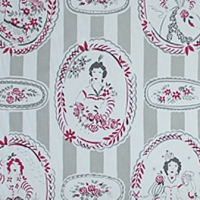Marimekko
Founder: Armi Ratia
Designer: Maija Isola
Armi Ratia had run an oil cloth company and wanted to branch out in to women's fashion. When Jackie Kennedy was photographed in their dresses on the front of top fashion magazines the status of the firm rose dramatically. However it wasn't until 1964 that the icon image Unikko was designed which is now synonymous with the Marimekko name.
 |
| http://www.madaboutthehouse.com |
 |
| Maija Isola at work, Wikipedia |
Ironically the designer Maija Isola reacted to Ratia's ban on floral designs with Unikko by creating a bold flora design which has been reproduced in many colourways around the world. The design is so popular it is reproduced on ceramics, stationery, headscarves and wash bags.
Born: 1941
Nationality: British
Studies: Salford School Of Art where she met the fashion designer, Ossie Clark. Birtwell designed the textiles for Clark's designs. In 2005 Birtwell was commissioned to produce a range of designs for Top Shop and in 2008 designed a range of outdoor wear for the high street chain Millets. Her online shop has a range of designs from fabric & wallpaper to Ossie Clark reproductions and illustrated books.
Images from http://www.celiabirtwell.com
Body Map
Designers: Stevie Stewart and David Holah
 |
| http://www.dazeddigital.com |
The Body Map look from that era were the black and white textile designs by Hilde Smith which were use to great effect in unusual pattern cutting and folding of the fabric. The patterns zigzag around the wearers body. Right is a classic image from the time.
In the early 1990s Bodymap closed down, they suffered from the recession at the time and Stewart and Holah went their separate ways to freelance design.
Research from:
http://www.davidholah.com
http://www.dazeddigital.com
Kaffe Fassett
Born: 1937
Nationality: American
 Studies: Museum of Fine Arts School in Boston. Moved to England in 1964. Following a visit to Shetland he was inspired by the wool and colours of the yarns to start knitting. He forged design alliances with the fashion firm Missoni and fashion designer Bill Gibb.
Studies: Museum of Fine Arts School in Boston. Moved to England in 1964. Following a visit to Shetland he was inspired by the wool and colours of the yarns to start knitting. He forged design alliances with the fashion firm Missoni and fashion designer Bill Gibb.  He has designed for many famous names and has had retrospectives at the V&A. Fassett's design is extremely intricate in both his knits and fabric work
He has designed for many famous names and has had retrospectives at the V&A. Fassett's design is extremely intricate in both his knits and fabric workImages and research taken from http://www.kaffefassett.com
William Morris
 |
| Willow (http://morris.artpassions.net/) |
Died: 3 October 1896
Nationality: British
Studies: Exeter College, Oxford
Possibly the best know British textile designer, Morris's designs and patterns are still very much in evidence. Morris had a life-long friendship with Edward Burne-Jones on of the founders of the Pre-Raphelite movement which also influenced Morris himself. Morris was also inspired by medieval architecture along with flora and fauna.
Morris used natural plant dyes for his designs and created his own dye recipes these created vibrant colours.
 |
| The Strawberry Thief (http://www.artsycraftsy.com) |
Research taken from:
http://www.antiquesjournal.com
The Timeless Designs of William Morris
Dr. Ilya Sandra Perlingieri
Copyright Dr. Ilya Sandra Perlingieri
http://en.wikipedia.org/wiki/William_Morris
The Timeless Designs of William Morris
Dr. Ilya Sandra Perlingieri
Copyright Dr. Ilya Sandra Perlingieri
http://en.wikipedia.org/wiki/William_Morris
Gunta Stolzl
Born: 1897
Died: 1983
Nationality: German
 |
| http://creativsphere.blogspot.co.uk |
Established dyeing facilities at the Bauhaus in the Weaving Workshop.
1927: Stolzl becomes a Junior Master at the Bauhaus with responsibility for weaving.
Moved to Switzerland to set up weaving workshops, exhibit and teach.
There is a strong use of colour in Stolzl work showing influences from Paul Klee and Wassily Kandinsky who were both working at the Bauhaus when she was there.
Beautiful colours are used for by Stolzls for her complex and intricate weaves.
 |
| Wall hanging in double-weave technique, Silk 1964 200x120 cm from the Zurich Workshop (http://www.guntastolzl.org) |
The mono-tone wall hanging to the left was produced much later in 1964 and is influenced by that era, being a much larger and bolder pattern than the previous designs.
Research:
http://www.guntastolzl.org
http://creativsphere.blogspot.co.uk


